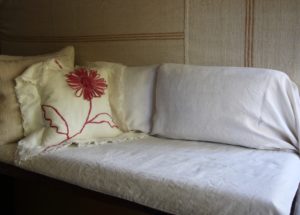Raffia of the type used for wrapping parcels stitched and couched onto off- white linen…
Palm trees ( Raphia) native to Madagascar and tropical Africa that also grow in the Philippines. Their plume-like leaves are the longest leaves in the world, reaching up to 18m (60ft) and produce long fibres that have many uses. locally they are used for ropes, sticks, supporting beam, and roof coverings; internationally for hats, floor rugs and a natural string. The underside of the leaf is taken off to create the long thin fibres that we use to tie things with – garden plants and presents. It takes dye easily, so is always available in the trending colours alongside dark greens and browns…
Properties
+ moisture-resistant and therefore suitable to outdoor use
+ soft and take dyes easily
+ biodegradable, so a popular eco-friendly resource
+ similar in appearance and use to rush.
Use
* twisted to make cord and ropes,
* it’s the flat uneven string that most of us have used for present wrapping at some time or another, in natural and many dyed colours
* woven or knotted to make hats, baskets, fashion accessories, rugs
* when made into a canvas it is similar to the Japanese grass cloth,
* it is the backing for the renowned Kuba cloth
* Yoruba, Bohol and Igbo cloth are all raffia based
* for durable floor and table matting products the long fibres are plaited for strength into strips of about 1 cm wide. These are then wound or folded in to shape and stitched through the sides to hold them in place-
* as canvasses that are generally woven at 60 to 70 cm wide x 120 – 140 cm long. Long lengths can be joined, made up into any size and shape.

